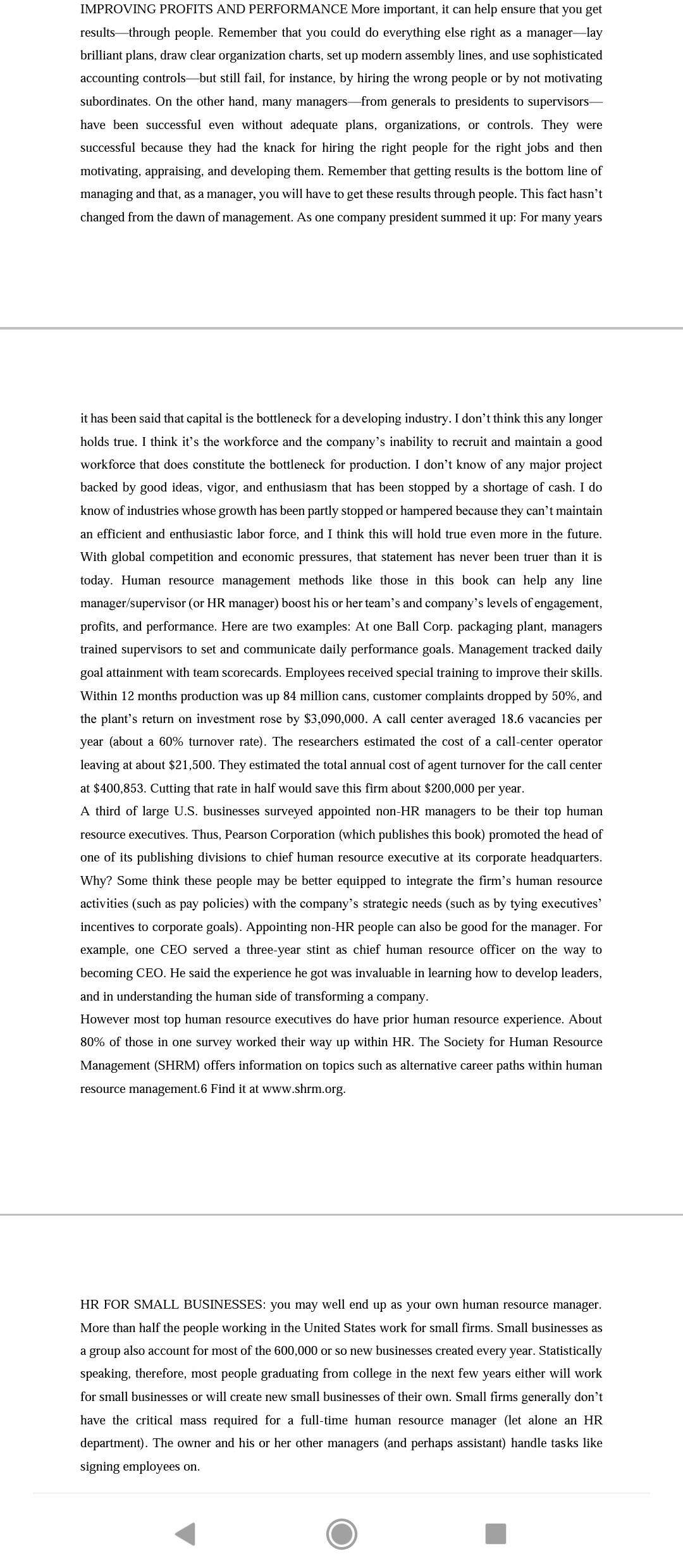Answered step by step
Verified Expert Solution
Question
1 Approved Answer
Question Define human resource management and explain how it contributes to achieving organizational goals? IMPROVING PROFITS AND PERFORMANCE More important, it can help ensure that
Question Define human resource management and explain how it contributes to achieving organizational goals?

IMPROVING PROFITS AND PERFORMANCE More important, it can help ensure that you get results through people. Remember that you could do everything else right as a manager-lay brilliant plans, draw clear organization charts, set up modern assembly lines, and use sophisticated accounting controls-but still fail, for instance, by hiring the wrong people or by not motivating subordinates. On the other hand, many managers-from generals to presidents to supervisors- have been successful even without adequate plans, organizations, or controls. They were successful because they had the knack for hiring the right people for the right jobs and then motivating, appraising, and developing them. Remember that getting results is the bottom line of managing and that, as a manager, you will have to get these results through people. This fact hasn't changed from the dawn of management. As one company president summed it up: For many years it has been said that capital is the bottleneck for a developing industry. I don't think this any longer holds true. I think it's the workforce and the company's inability to recruit and maintain a good workforce that does constitute the bottleneck for production. I don't know of any major project backed by good ideas, vigor, and enthusiasm that has been stopped by a shortage of cash. I do know of industries whose growth has been partly stopped or hampered because they can't maintain an efficient and enthusiastic labor force, and I think this will hold true even more in the future. With global competition and economic pressures, that statement has never been truer than it is today. Human resource management methods like those in this book can help any line manager/supervisor (or HR manager) boost his or her team's and company's levels of engagement, profits, and performance. Here are two examples: At one Ball Corp. packaging plant, managers trained supervisors to set and communicate daily performance goals. Management tracked daily goal attainment with team scorecards. Employees received special training to improve their skills. Within 12 months production was up 84 million cans, customer complaints dropped by 50%, and the plant's return on investment rose by $3,090,000. A call center averaged 18.6 vacancies per year (about a 60% turnover rate). The researchers estimated the cost of a call-center operator leaving at about $21,500. They estimated the total annual cost of agent turnover for the call center at $400,853. Cutting that rate in half would save this firm about $200,000 per year. A third of large U.S. businesses surveyed appointed non-HR managers to be their top human resource executives. Thus, Pearson Corporation (which publishes this book) promoted the head of one of its publishing divisions to chief human resource executive at its corporate headquarters. Why? Some think these people may be better equipped to integrate the firm's human resource activities (such as pay policies) with the company's strategic needs (such as by tying executives' incentives to corporate goals). Appointing non-HR people can also be good for the manager. For example, one CEO served a three-year stint as chief human resource officer on the way to becoming CEO. He said the experience he got was invaluable in learning how to develop leaders, and in understanding the human side of transforming a company. However most top human resource executives do have prior human resource experience. About 80% of those in one survey worked their way up within HR. The Society for Human Resource Management (SHRM) offers information on topics such as alternative career paths within human resource management.6 Find it at www.shrm.org. HR FOR SMALL BUSINESSES: you may well end up as your own human resource manager. More than half the people working in the United States work for small firms. Small businesses as a group also account for most of the 600,000 or so new businesses created every year. Statistically speaking, therefore, most people graduating from college in the next few years either will work for small businesses or will create new small businesses of their own. Small firms generally don't have the critical mass required for a full-time human resource manager (let alone an HR department). The owner and his or her other managers (and perhaps assistant) handle tasks like signing employees on.
Step by Step Solution
★★★★★
3.48 Rating (145 Votes )
There are 3 Steps involved in it
Step: 1
Human resource management and its contribution to achieve organizational goals Human resource management HRM refers to the practice of hiring recruiti...
Get Instant Access to Expert-Tailored Solutions
See step-by-step solutions with expert insights and AI powered tools for academic success
Step: 2

Step: 3

Ace Your Homework with AI
Get the answers you need in no time with our AI-driven, step-by-step assistance
Get Started


